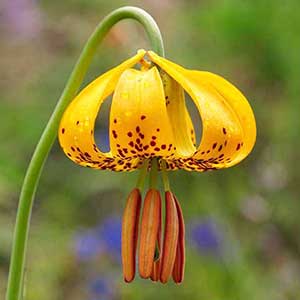Lilium columbianum
Lilium lancifolium
Columbia lily, Columbia tiger lily, Columbian lily, Oregon lily, tiger lily
lance-leaf tiger lily, lis tigré, tiger lily
variable, subrhizomatous to ± ovoid, 3.1–8.1 × 3.6–10.6 cm, 0.3–1.4 times taller than long;
scales 2–3(–5)-segmented, some unsegmented, longest 3.1–7.3 cm;
stem roots absent.
widely ovoid, 3.5(–8) × 4–8 cm, ca. 0.7–0.8 times taller than wide;
scales broad, unsegmented, longest ca. 3–4 cm;
stem roots usually present.
to 1.7 m, glaucous or not.
white-lanate, purplish, to 2 m.
rounded in cross section.
usually flat-sided, somewhat triangular in cross section.
in 1–9 whorls or partial whorls, 3–25 leaves per whorl, usually ascending, 1.7–15.7 × 0.4–4.7 cm, 2.4–7.4 times longer than wide;
blade weakly oblanceolate to obovate or ± elliptic, margins usually somewhat undulate, apex acute;
veins and margins ± smooth abaxially.
scattered, horizontal and drooping at tips, 10–15(–18) × ca. 1.5 cm, ca. 3–6(–10) times longer than wide, distal bearing 1(–3) dark purple axillary bulbils;
blade lanceolate, often narrowly so, margins not undulate, papillose, apex white-lanate, narrowly acute (rounded in distal leaves).
racemose, 1–25(–45)-flowered.
racemose, 3–6(–25)-flowered.
pendent to nodding, not fragrant;
perianth Turk’s-cap-shaped;
sepals and petals reflexed 2/5–1/2 along length from base, yellow or orange to occasionally red, with copious maroon spots, often darker and especially reddish abaxially, not distinctly clawed;
sepals not ridged abaxially, appearing wide for their length, 3.4–7.1 × 0.8–1.9 cm;
petals 3.5–6.9 × 0.8–1.9 cm;
stamens barely to moderately exserted;
filaments moderately spreading, diverging 10°–20° from axis;
anthers pale yellow to yellow, 0.5–1.3 cm;
pollen orange or yellow;
pistil 2.4–3.7 cm;
ovary 1.1–2.2 cm;
style green;
pedicel 2.8–20.2 cm.
pendent, not fragrant;
perianth Turk’s-cap-shaped;
sepals and petals reflexed ca. 1/5–1/4 along length from base, orange with many purple-brown spots, not distinctly clawed, 7–10 × 1–2 cm, adaxial base bearing pubescent strip;
sepals not ridged abaxially;
stamens strongly exserted;
filaments very widely spreading, diverging ca. 25° from axis;
anthers purplish, ca. 2 cm;
pollen rust;
pistil 6–9 cm;
pedicel sometimes dichotomous, stout and relatively short, to 10 cm.
2.2–5.4 × 1.1–2 cm, 1.7–3.3 times longer than wide.
3–4 cm.
135–330.
not counted.
= 24.
= 24, 36.
Lilium columbianum
Lilium lancifolium
The author citations often seen for this species derive from Baker (1874), who published the name as Lilium columbianum “Hanson in hort., Leichtlin”; this authority is given by various later writers as Hanson, or Baker, or Hanson ex Baker. However, Ducharte’s (1871) recapitulation of a letter from M. Leichtlin is apparently the first confirmed and valid publication of L. columbianum, and hence that citation is used here.
This widespread lily is rather variable. In California plants the stamens are considerably less exserted than those of plants found farther north. Lilium columbianum may intergrade with L. kelloggii along Highway 199 at the border between California and Oregon; these plants are slightly fragrant, the stamens moderately exserted, and the bulb scales unsegmented. Lilium columbianum hybridizes with L. pardalinum subspp. wigginsii and vollmeri, and extensively with L. occidentale in Oregon.
Lilium columbianum is pollinated primarily by rufous hummingbirds [Selasphorus rufus (J. F. Gmelin), family Trochilidae] and to a lesser extent by large butterflies, including the pale swallowtail (Papilio eurymedon Lucas, family Papilionidae).
Native Americans used Lilium columbianum bulbs as a food or peppery condiment, sometimes mixed with meat or salmon roe. For many, it was a staple food (J. Pojar and A. MacKinnon 1994).
(Discussion copyrighted by Flora of North America; reprinted with permission.)
Throughout most of modern botanical history this Chinese lily has been known as Lilium tigrinum, but recent nomenclatural reassessment affirms that Thunberg’s description, published sixteen years earlier than Ker Gawler’s, applies to this species. Though many North America species are known vernacularly as tiger lilies, the name is properly applied only to this one. Along with L. candidum, it is considered to be among the earliest domesticated lilies (H. D. Woodcock and W. T. Stearn 1950), no doubt because it is handsome, easy to grow, and the bulbs are edible and substantial. It is widely planted in North America, usually as a sterile triploid that is best propagated from the bulbils.
Perhaps the hardiest garden lily, Lilium lancifolium is a widespread but sporadic garden escape, and roadside lilies near habitation in eastern and northeastern North America are often this species. Despite its general use in gardens, it seems to be naturalized only in the better-watered eastern portion of the continent.
In North America, the tiger lily is rather easily diagnosed by its truly lanceolate and widely sessile alternating leaves that bear dark bulbils on the upper stem. The mature buds are usually high-shouldered and taper rather evenly to a flattish apex with three greenish, terminal, rounded processes. No native lily consistently displays any of these features.
(Discussion copyrighted by Flora of North America; reprinted with permission.)
- Local floras:
BC,
CA,
OR,
WA
- Local Web sites:
CalFlora,
CalPhotos,
Flora NW,
PNW Herbaria,
Turner Photog.
WildflowerSearch
iNaturalist (observations)
USDA Plants Database
- LBJ Wildflower Center
- SEINet
- Plants of the World Online
- Encyclopedia of Life
- Wikipedia
- Google Image Search
- Local floras:
BC
- Local Web sites:
Go Botany,
IL Wildflowers,
LA Plants,
MD Biodiversity,
MI Flora,
MN Wildflowers,
MO Plants,
PNW Herbaria
WildflowerSearch
iNaturalist (observations)
USDA Plants Database
- LBJ Wildflower Center
- SEINet
- Plants of the World Online
- Encyclopedia of Life
- Wikipedia
- Google Image Search


